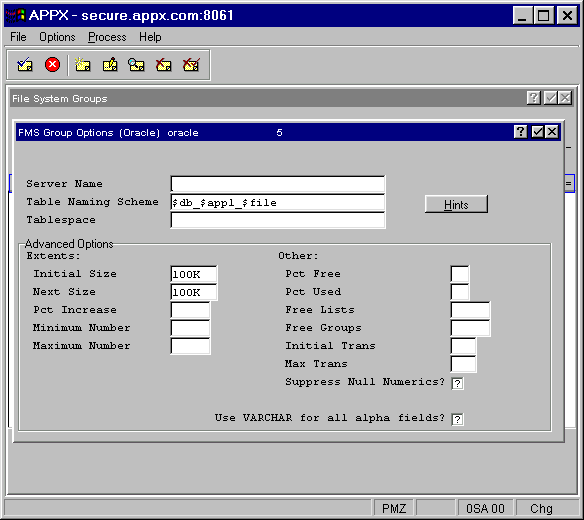
If you select the FMS Group Attributes option in File System Groups File Maintenance for a file system group with FMS type 5, the FMS Controls overlay for Oracle appears as shown in Figure 2-20 below.

Figure 2-20. FMS Controls Overlay for Oracle (Type 5)
The Oracle overlay contains the fields discussed below. Consult your Oracle database administrator for help in completing these fields.
· Server Name indicates the name of the server on which the file system resides.
· Table Naming Scheme assists APPX in translating its 8-character file names to Oracle’s external table names. If users will be accessing Oracle at the File System Group level, then a “Table Naming Scheme” is entered here. Select the Hints option for help on constructing a table-naming scheme. See the Table Naming Scheme Hints section for an example of the Hints overlay. If you intend to override these parameters at the file level in Database Management, then you can leave this field blank and enter an explicit table name there.
· Tablespace defines the disk allocation for this database. It may be a portion of a file system, or it may include multiple physical disk drives. “Tablespace” is an Oracle term; you should look in their documentation for additional information to help you enter an appropriate value for this field.
· Initial Size specifies the size of the first extent (block of data stored on disk) in bytes, kilobytes or megabytes. For example, if you want to reserve 100 bytes, enter 100; to reserve 100 kilobytes, enter 100K; to reserve 100 megabytes, enter 100M.
· Next Size specifies the size of the next extent in bytes, kilobytes or megabytes. As with Initial Size, adding “K” or “M” to the number reserves it in kilobytes or megabytes respectively.
· Pct Increase specifies the percentage by which each extent after the second will increase over the previous extent.
· Minimum Number specifies the number of extents to be allocated when the database is created.
· Maximum Number specifies the maximum number of extents to be allocated for this database.
· Pct Free specifies the percentage of space to be reserved in each data block for future updates to rows contained in that block.
· Pct Used specifies the minimum percentage of space that will be maintained as used in each data block.
· Free Lists specifies the number of free lists contained in each free list group of the table.
· Free Groups specifies the number of groups of free lists for the table.
· Initial Trans specifies the initial number of transaction entries allocated to each block.
· Max Trans specifies the maximum number of transaction entries allocated to each block.
· Suppress Null Numerics? determines whether or not to disable the null numeric feature inherent in the database; answer "yes" ![]() if you want to be consistent with APPXIO behavior which does not have this capability (a zero entry cannot be distinguished from a null value in APPXIO).
if you want to be consistent with APPXIO behavior which does not have this capability (a zero entry cannot be distinguished from a null value in APPXIO).
· Use VARCHAR for All Alpha Fields? indicates whether all alphanumeric fields will be defined as variable length, even key fields. Variable length key fields can negatively affect system performance. If this item is set to “yes” ![]() , then APPX will assign the VARCHAR field type to all alphanumeric fields. If this item is set to “no”
, then APPX will assign the VARCHAR field type to all alphanumeric fields. If this item is set to “no”![]() , then APPX will assign the CHAR field type (fixed length, 30 characters) to key fields and alphanumeric fields of less than six characters, and the VARCHAR field type to all other alphanumeric fields.
, then APPX will assign the CHAR field type (fixed length, 30 characters) to key fields and alphanumeric fields of less than six characters, and the VARCHAR field type to all other alphanumeric fields.